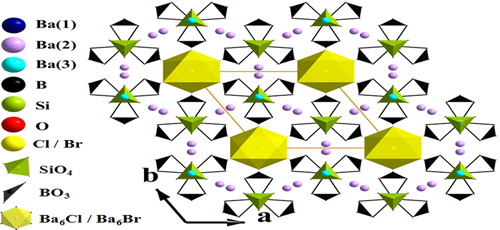New Salt-Inclusion Borosilicate Halides as Potential Deep UV Nonlinear Optical Materials Synthesized
Editor: | Mar 25,2014
Borosilicates have attracted much attention due to their many potential applications and abundant new structural types from the combination of the flexible coordination geometries for both B and Si atoms. As is known to all, inorganic compounds with polar coordination units are more likely to display NCS structures and exhibit good SHG properties. It has been proved to be fruitful in obtaining polar structures by inclusion of an asymmetric salt unit as well as monatomic halide anions as a template.
In order to design and discover new NLO crystals, approaches by the inclusion of the acentric salt units as polar template are often adopted.
Researchers analyzed about the “Polar Templating” Effect of XBa6 salt inclusion units, the results indicate that the material may crystallize in an NCS structure when the distorted direction of the acentric XBa6 SBU are in a parallel manner so that producing macroscopic acentricity.
The research results have been published in the J. Mater. Chem. C, 2014.
This work is supported by the “National Natural Science Foundation of China”, the Foundation of the Youth Innovation Promotion Association of CAS, 973 Program of China, etc.

Fig.1 The 3D framework of Ba4(BO3)3(SiO4)·Ba3X(X = Cl, Br) (Image by XTIPC).
附件下载:
 (86) 991-3838931
(86) 991-3838931 lhskj@ms.xjb.ac.cn
lhskj@ms.xjb.ac.cn (86)991-3838957
(86)991-3838957 40-1 Beijing Road
Urumqi, XinjiangChina
40-1 Beijing Road
Urumqi, XinjiangChina